It’s taken me years but the recent obsession with UK psychedelia led me to finally watch Joe Massot’s piece of cinematic fluff from 1968, Wonderwall, a film distinguished primarily for its score by George Harrison (with Ringo Starr and Eric Clapton playing pseudonymously), and its title which was swiped years later by a bunch of Rutles-imitators from Manchester. The story is so slight it would have barely sustained an hour-long TV film: absent-minded scientist (Jack MacGowran) becomes intrigued by his glamorous neighbour (Jane Birkin playing “Penny Lane”; yeah, right…) and knocks holes in the walls of his flat in order to scrutinise her modelling, partying and frequent undressing. Unlike Blow Up (1966, and also featuring Jane Birkin) and the later Performance (1970), both of which attempted to accurately pin down some of the modish aspects of the period, this is a very kitsch piece. That wouldn’t be so bad if it was entertaining kitsch like, say, Smashing Time (1967), but Massott has to resort to scenes of limp comedy and some rather dull dream sequences in order to pad the thing out. Between the handful of actual dialogue scenes there’s a lot of gloating over Ms Birkin’s flesh which no doubt satisfied one half of the audience but by today’s standards is hardly thrilling. Iain Quarrier plays Penny’s duplicitous boyfriend (with a fake Liverpool accent) in his last screen role before he quit acting. Quarrier and MacGowran had appeared together in two of Roman Polanski’s British films, Cul-de-sac (1966) and Dance of the Vampires (1967). In the latter, MacGowran again plays an absent-minded scientist while Quarrier is cinema’s first (?) gay vampire.
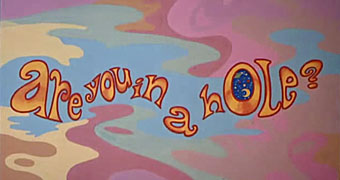
An interjection from The Fool.
Of chief interest for me in Wonderwall was the decor and title card decorations by Dutch psychedelic collective, The Fool (who also appear in the party scene), famous for their earlier Beatles associations including the inner sleeve for Sgt Pepper and designs for the short-lived Apple Boutique in London’s Baker Street. I was also curious about the distinctive decor of MacGowran’s flat which contrasts with the psychedelia next door, all dark green walls embellished with Victorian murals and a Tennyson poem—very fittingly a piece called The Daydream—which circles the room.
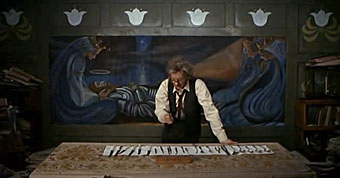
The professor prepares to attack the wall.
This was particularly interesting in that it made another connection between the psychedelic era and Victorian arts movements, especially from the Aesthetic/Arts & Crafts end of things, but it wasn’t at all obvious whether the connection was an intentional part of the film’s production design or an accident of location and budgetary convenience. Aside from the old-fashioned appearance of MacGowran’s rooms there seemed no reason why his otherwise cultureless character would have any interest in decorating his living space in this way.
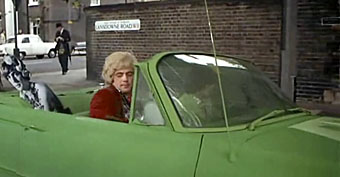
The street corner then…

…and now.

The building itself is equally distinctive and an exterior shot conveniently shows a street sign placing the location in Lansdowne House, a Victorian apartment block on the corner of Lansdowne Road and Ladbroke Road in the Notting Hill/Holland Park area of London.
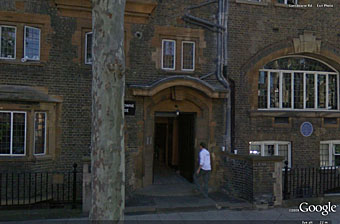
Lansdowne House.
What did the building look like today, I wondered? Google Earth proves indispensable at times like this and it was easy to find, in a street which looks more cramped than it does in the film. The presence of a blue plaque on the wall proved intriguing, a sign that the place once had famous residents. Googling for that revealed this photo which was a real surprise: Lansdowne House at one time contained studios for artists who included Charles Ricketts and Charles Shannon, a gay couple and leading lights of London’s fin de siècle art scene (also friends of Oscar Wilde), and another artist, James Pryde, who with William Nicholson worked as The Beggarstaffs. So my suspicion about the Arts & Crafts decor was correct, which means that MacGowran’s flat may have been decorated that way originally and remained untouched since the 1890s. I haven’t seen Rhino’s special edition of Wonderwall which contained additional information about the making of the film, so have no idea whether the history of the building is mentioned there. If anyone does know, please leave a comment. For now I’m quite happy to have stumbled upon another minor link between two of my favourite art decades.
For more visuals, this page has a host of screen grabs from the film as well as some gif animations, all of which manage to make Wonderwall seem more interesting than it is when you’re watching it.
Previously on { feuilleton }
• Charles Ricketts’ Hero and Leander
• Images by Robert Altman

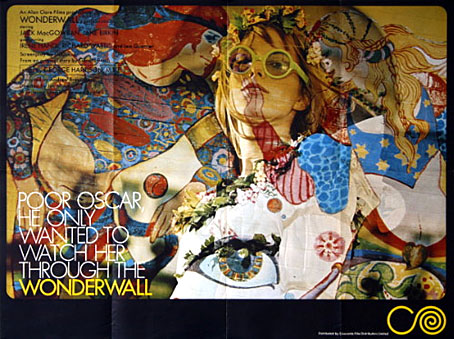
I have to admit, i love this film. But my critical faculties go out of the window when it comes to things touched by the hand of British psychedelia.
I admit that its far from perfect, but it has an almost dreamlike quality that makes it interesting. The humour fails, the plot doesnt exist,none of the characters are interesting, BUT…….cant explain it……..something to do with the decor? the party scene? the music?(might have hit on it here, the eerie indian/freakbeat soundtrack is amazing).
Unlike performance, say, Wonderwall is very much rooted in its time, it makes no sense looking at it with modern eyes.Maybe its innocence is what i find so appealing. And that wardrobe too!!!
There are several British films of this era i find worthwhile but cant really claim to be great films : The Touchables, Groupie Girl,Whats Good For The Goose(with Norman Wisdom),Be Glad For The Song Has No Ending,Privilege,Here We Go Round The Mulberry Bush,Toomorrow, ect.Sometimes the kitsch of an era is more revealing than the great art.
Id always presumed the professors flat was also decorated by the Fool – the same arts and crafts/noveau influence but in a subdued style.
The 1960s were the 1890s turned upside down. Or was it inside out? Or is it the other way round?
The 1920s were good too.
Sure you know about rhizome.org – Eno’s favourite website – but there’s ever more psychedelia:
http://www.rhizome.org/editorial/2858
Hi Sloane Fan. No, I didn’t know about Rhizome.org, thanks.
Lord Plum: Yes, it’s perfectly possible, not to say likely, that The Fool also decorated the professor’s flat, I was intrigued by the possibility that they hadn’t. That Tennyson poem, for example, has no attention drawn to it, and I wouldn’t have even guessed what it was if I hadn’t paused the film then run a search on one of the lines. So it seems an extravagantly superfluous detail if it was intentional.
When it comes to cinema I often prefer technique over exuberance, so I’d much rather watch, say, a Hitchcock thriller than a trashier and more grotesque horror film. I’ve never liked Antonioni all that much but there’s more in Blow Up to hold my attention than in flashier films simply because of the way he frames the shots. This probably sounds snobby which it isn’t, I’m often defending pulp stuff, and I like Swinging London films in general (although that Norman Wisdom film is profoundly depressing!) but this one didn’t work for me as well as it might.
The thought of an original arts and crafts interior being destroyed by an unfunny comedian to make wonderwall doesnt bear thinking about.The house i live in is 150 years old, and when i first moved in and was stripping off the paintwork in one of the rooms i revealed a crude hand painted art noveau mural. It was too badly damaged to preserve,and i didnt think to photograph it, but it was like a ghost of another time peeking into the present,a reminder that the place i live in has a history, and a link to the Mauve Decade.
Its always imagery that captures my imagination in films, way before plot or characterisation or whatever.I often think of them as moving paintings rather than narratives.And i guess i just love trash.I try not to make much distinction between high and low art.Just let it all swim around in my melted plastic brain and see what comes out.
(The Norman Wisdom film has footage of the Pretty Things performing some of their best songs, and my straight friends liked Sally Geesons topless scene, but i take your point…..)
“i urge you: learn to look at “bad” films, they are often so sublime” – Ado Kyrou, Le Surrealism Au Cinema
Have you seen this site?
http://www.surrealmoviez.info/news.php
I guess “extravagantly superfluous” describes the fool perfectly!!